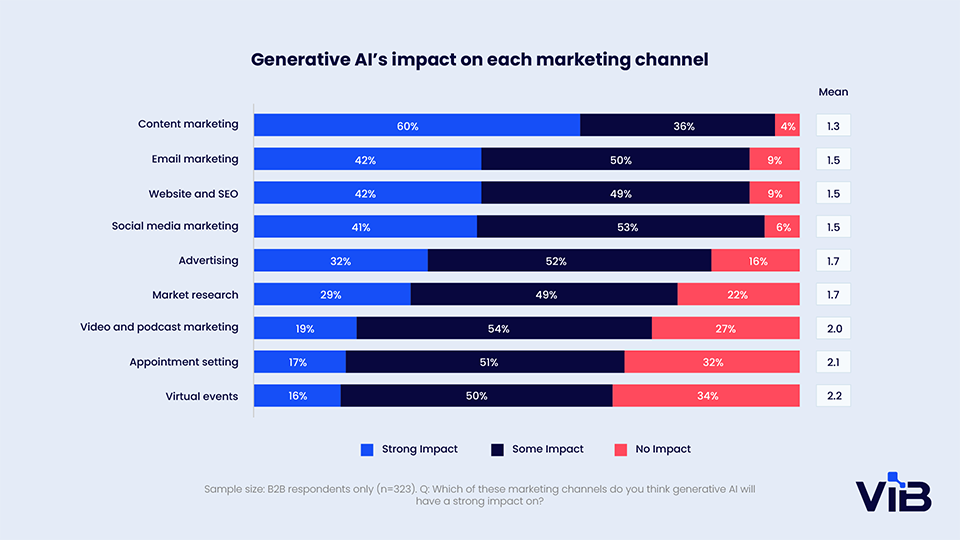If there’s one industry that’s witnessing a seismic shift thanks to generative AI, it’s marketing. And this transformative technology is now making its mark in the B2B technology marketing world as well.
In fact, according to B2B demand generation partner ViB, a staggering 85% of B2B marketers recognize the positive impact of generative AI on B2B marketing, and 41% of marketers have formalized plans to adopt AI in 2023.
However, with generative AI still being uncharted territory, how can B2B marketers effectively leverage its potential, while being mindful of its risks?
In this blog, we delve into ViB’s latest B2B marketing trends and AI statistics, unveiling three strategic approaches that B2B marketers can adopt to stay ahead in the era of generative AI.
1 – Embrace AI To Create Content, With Data Privacy In Mind
Think generative AI, think speedy content production. Copywriting tools can churn out content at a pace that is impossible for humans. This frees up valuable time for marketers to redirect their efforts towards other crucial tasks throughout the workday.
According to the research, content marketing is where we’re seeing the strongest impact of generative AI, with 96% of B2B marketers acknowledging some to strong impact.

Additionally, compared to a freelance writer, AI is a fraction of the price, making it cost-efficient for small businesses and startups with limited resources.
However, it’s essential for marketers to exercise caution when sharing proprietary product content or confidential information on AI platforms like ChatGPT, to mitigate the risks of potential data leaks or breaches — which have already happened.
Because copywriting tools pull data from the web (i.e. data belonging to other individuals and organizations), plagiarism and privacy violations are a concern too. Consent for data release is implied in most of the United States, but we can’t be so sure of the legality of AI tools with the privacy laws in Europe, or what changes will come in time.
Before publishing anything, it’s important to verify the originality of the AI-assisted output, such as by pushing your content through a plagiarism tool. Beyond that, staying updated with the unregulated privacy laws of these technologies is a must.
2 – Use AI To Repurpose, Personalize and Iterate
With a single pre-written content piece as a foundation, there’s no limit to iterations with generative AI. In fact, repurposing content is the #1 trend marketers are adopting this year, ahead of generative AI which is still making its way up.
Copywriting tools can personalize your existing content for specific verticals, or edit it for particular use cases — at scale. This approach enables you to efficiently create tailored content that addresses the unique needs and preferences of your target market, enhancing engagement and conversion rates.
In terms of tools you should be using, 61% of marketers are implementing or exploring ChatGPT, and 53% for Grammarly, a cloud-based typing assistant. These platforms can assist you in brainstorming new ideas, even helping write outlines so that you can get to content creation more quickly.
Generative AI can also be beneficial for those marketers who are new to SEO, or need help to consistently improve a large volume of SEO content. Remember, AI tools pull words from content that’s crafted with SEO in mind. That’s why AI can assist with keyword insertion and article structure, resulting in better SEO pieces that you can also iterate on over time.
3 – Combine AI with Human Oversight and Value
While AI-generated content can save time and resources, human oversight is essential to ensure the quality and accuracy of the content.
Of all the risks we’ve flagged so far, the quality of AI-generated material is the most severe concerns, with 59% of B2B marketers agreeing.
The best practice? Don’t regard AI as a replacement for human writers, and never rely solely on what an AI platform presents.
Instead, AI should be here to augment your existing resources. Always take the generated content and have human marketers review, edit, and enhance it to ensure it adheres to brand standards, is optimized to be readable.
One last point to add — human oversight is also all about adding a human touch and value to your content. Ways to achieve this include:
- Providing AI tools with your own outline and key points
- Collecting quality commentary from thought leaders in your network
- Conducting custom research to infuse your pieces with fresh statistics
By incorporating originality into the AI-generated content, you can ensure that it resonates with your audience and sets your brand apart from others in the industry.
Final thoughts
AI-generated content is a boon to businesses with limited resources and tight deadlines. But it shouldn’t be treated as a catch-all solution to replace humans in content creation.
Instead, use it to augment work being done by humans, and stay up to date with changes in legislation and regulations that may arise as AI technology develops. By following these best practices, generative AI can be a game-changer for B2B marketing.
All statistics and trends presented in this article are derived from ViB’s State of B2B Marketing survey, which involved insights gathered from over 300 B2B marketing professionals in the technology sector. To access the full report, visit http://vib.tech/resources/marketing-blogs/b2b-marketing-trends
Interesting Related Article: “How to Boost Your B2B Ecommerce Success“
